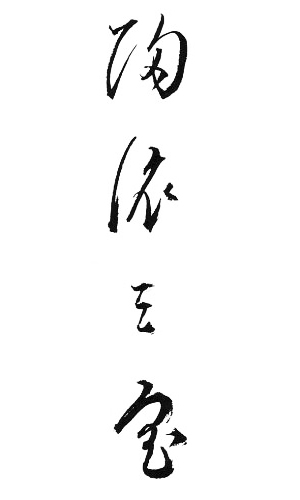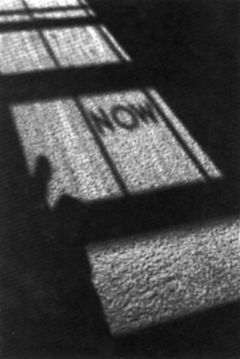No one can live your life except you. No one can live my life except me. You are responsible. I am responsible. But what is our life? What is our death?
In Soto Zen we have the expression “the treasury of the true dharma eye and subtle mind of nirvana.” This expression comes from a famous koan which relates the transmission of the dharma from our original teacher, Shakyamuni Buddha, to his successor, Mahakashyapa. In the story, Shakyamuni Buddha held up a flower and blinked. Mahakashyapa smiled, and Shakyamuni Buddha said, “I have the treasury of the true dharma eye and subtle mind of nirvana, and I transmit it to Mahakashyapa.” What is this treasury of the true dharma eye and subtle mind of nirvana that Shakyamuni Buddha transmitted to Mahakashyapa? All the Buddhist teachings deal with this most precious treasure. It is your life. It is my life.

Another way of asking that question is, “Who am I?” “What is this?” These inquiries are the fundamental, most important koans. Like all koans, we must answer them out of our own life. What is our life? And knowing what it is, how are we living it? How can we experience the life that we are living now as an infinite, literally limitless life, as the subtle mind of nirvana? For the irony is that we are all living such a life, we are all living this treasure, and we are also not quite living it either. In other words, our life is no other than the treasury of the true dharma eye and subtle mind of nirvana, and yet we see it as something other than this. We do not see that our life right here, right now, is nirvana. Maybe we think that nirvana is a place where there are no problems, no more delusions. Maybe we think nirvana is something very beautiful, something unattainable. We always think nirvana is something very different from our own life. But we must really understand that it is right here, right now.
How is that possible? We can say that our practice is to close the gap between what we think our life is and our life as the subtle mind of nirvana. Or more to the point, how can we realize that there is really no gap to begin with?
Do not be dualistic. Truly be one with your life as the subtle mind of nirvana. That is what subtle means. Something is subtle not because it is hidden, nor because it is elusive, but because it is right here. We don’t see it precisely because it is right in front of us. In fact, we are living it. When we live it we don’t think about it. The minute we think about it, we are functioning in the dualistic state and don’t see our life as the subtle mind of nirvana.
Why is this so difficult to do? Pin down what the difficulty is and where it comes up. Most of us know that this I is somehow blocking us from realizing our life as the subtle mind of nirvana. I am the one who does not see my life in this way. I am the one who is not experiencing life as the treasure. What is this I that is blocking this realization?
It is my dualistic functioning. There is nothing wrong with duality itself, that is how our mind functions. But as long as we remain in the confinement of duality, we are swayed by such opposing values as right and wrong, good and bad. These are only temporary aspects. Something appears sometimes to be good or bad or right or wrong or long or short or big or small – but what is it overall? The same thing with our life. We must see what it is beyond duality. Our life literally comes down to right now. Now! Here! What is it?
One understanding of life and death is the life and death of the instant. According to Dogen Zenji, the founder of Japanese Soto Zen, Shakyamuni Buddha said that in twenty-four hours our life is born and dying, rising and falling, 6,400,099,980 times. So in one second our life is born and dies around 70,000 times. Our conscious mind cannot even imagine such an occurrence. What kind of life is this?
We usually think of our life as fifty years, sixty years, maybe the most around one hundred years. I once read that there are about thirty-three hundred people who are more than one hundred years old, the oldest being one hundred twelve years. (What are people doing living such long lives?) Dogen Zenji said that living a long life without awareness is almost a crime. On the contrary, he emphasized that even if you live one day with a clear understanding of what life is, the value of that one day is equal to many, many years of living without awareness. We are all so concerned with how long we will live. We feel that living eighty, ninety, or a hundred years is a wonderful life. Maybe so, but wonderful compared with what? Compared with those who die young?
We must see our life clearly. The existence of this life at this very moment, what is it? Being born and dying six or seven thousand times, being born and dying at this very moment—what is it? Is such a life different for a man, a woman, a young person, an old person, a human being, or other beings? Is such a life dualistic? Is it relative or absolute? All our usual considerations and understanding about what our life is make no sense if we are born and we are dying seven thousand times in an instant.
Dogen Zenji says that because our life is this, we attain realization. We do not practice in order to attain realization; in fact, when we practice, we do not need to expect anything. Why not? Because everything is already here! Our life is this wisdom! Our practice is this realization. When we see our life beyond duality, beyond thinking and nonthinking, then everything is already no other than the treasury of the true dharma eye and subtle mind of nirvana! When we think in dualistic terms, our life is restricted: I am, you are, this is good, this is bad. At the same time, our life has no boundary. Since we are born and die in each moment, in each instant, our life is not limited by time and space. Everything is right here, right now!

So our life is limited when we think dualistically, and at the same time it is not limited. It does not matter whether you are a man or woman, young or old, a monk or a layperson. The treasury of the true dharma eye and subtle mind of nirvana is anybody, everybody!
All of us have abundant opportunities to experience our life in this way at this very moment. How can we realize the Supreme Way manifesting as our life? For whether we realize it or not, being born and dying, renewing our life thousands of times per second, we are always living this unsurpassable life – just as we are. But how do we realize this? Just be! Just do! When we live with this awareness, we realize that there is no division between this life and the Supreme Way, no division between this life and the subtle mind of nirvana. We realize the life that has no division!
This is our life. This is our practice also. So if your practice is breathing, be one with breathing! If your practice is shikantaza, or just sitting, then just sit! If your practice is koan, be the koan! Are you truly practicing in this way? If you are doing shikantaza based on a certain understanding or expectation, your practice is not shikantaza. If you are practicing with a koan intellectually or as a riddle to solve, you are not functioning as a koan. Why not? Because duality is still involved! Because division is still involved.
How can you experience and confirm your life as the true dharma eye and subtle mind of nirvana? You are already so! Start at least with believing that your life is this. Have faith in this! Then experience that life as your very own! When you do this, right there your life is prajnaparamita wisdom itself. Prajna is the wisdom of no duality, no I, you, good, or bad. It is the functioning of this moment, of what happens here and now. Paramita means “to have reached the other shore.” What other shore? If everything is right here and now, what other shore exists? Some people think that the other shore is nirvana, the way we think things should be, the way we wish our life to be. But nirvana is already here. Having gone to the other shore, we confirm that this life right now is the treasury of the true dharma eye and subtle mind of nirvana. This life is that most precious treasure, the unsurpassable Way, the way of true realization.
Shakyamuni Buddha himself loved this life. What is the difference between his life and our life? At the moment of his great enlightenment, Shakyamuni Buddha said, “How miraculous! All beings have the wisdom and virtue of the Tathagata Buddha!” Shakyamuni Buddha’s confirmation of what we are, of what our life is, and of how to live is our koan. We must live it and practice it. Do you understand this?
Each of us has to take care of this treasury of the true dharma eye and subtle mind of nirvana. We must do it. One day is long enough. One sitting period is long enough. Even one second is long enough. And vice versa. A week, ten years, fifty years, or a hundred years may not be long enough. In order to experience yourself in this way, you do not need to wait for any moment.
In fact, do not wait!
We have these marvelous teachings about our life. I encourage you. Please enjoy this wonderful life together. Appreciate the world of just this! There is nothing extra. Genuinely appreciate your life as the treasury of the true dharma eye and subtle mind of nirvana.
♦
From Appreciate Your Life: The Essence of Zen Practice © 2002 by Taizan Maezumi and Wendy Egyoku Nakao. Reprinted with permission of Shambhala Publications.